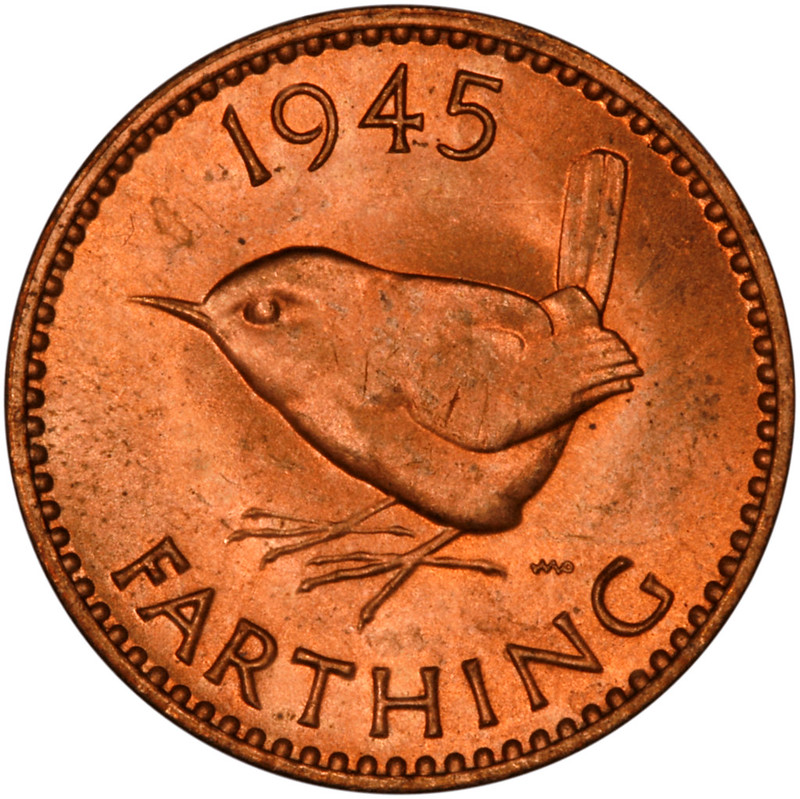The Story of the Farthing Coin
Synopsis
Taking its name from the functionality of an existing piece of coinage, the farthing coin derived fromt he splitting of the popular silver penny coin, with the cross design featuring on the reverse acting as a guide when breaking the piece into halves or quarters. This act was refered to as "halving" and "fourthing" appropriatly, with the name Farthing deriving from "fourthing" or "feorling".

The First Farthing
Although round halfpenny coins had been issued as early 886 during the rule of Alfred the Great, the denomintion was produced under most monarchs, but never in excessive quantities.

Introduction of the round Farthing
The first round Farthing was issued in 1279 under the rule of Edward I. Unlike later versions of the coin, like its spiritual predecesor, the original farghing was produced using silver. However, the silver Farthing was short lived with Edward VI halting production in 1553.
Farthing Production Suspended
No Farthing coins were produced during the reign of Mary and Philip. The small quantities in which these coins were producedwas the cost of production.
The Three-Fathring
The monarch was reluctant to make a loss on each coin they minted in such small denominations. To challenge this Elizabeth I minted the first silver Three-Farthing Coin, distinguiahable from shillings, groats and pennies by the Rose behind the portrait of Elizabeth.

Britain's First Copper Coin
Under James I, copper farthings were produced. At first these were produced privately under licence from the Crown, first by Lord Harrington, then by Lennox. The licence changed hands several times, and privately issued copper farthings continued to be produced under Charles I. After Charles I got the chop, a copper farthing was issued by Oliver Cromwell, bearing his portrait.

Regal Copper and Charles II
From 1672, a good quality regal copper coinage of farthings and halfpennies was produced for Charles II. These featured Britannia as a reverse design. The first time Britannia had been used on British coins. Previously Britannia had only appeared on Roman coins alluding to Britain.
The Adoption of Tin
Still under Charles II, tin farthings were produced in 1684 and 1685, to help the Cornish tin industry. These were made with a small plug of copper, and using a design similar to the copper issue, except that the date appears on the edge of the coin, which also carries the inscription NUMMORUM FAMULUS.
James II
Tin continued to be used for farthings under James II, when tin halfpennies were also produced, and also under William and Mary until 1692. However, copper Farthing coins were once again introduced in 1694 thanks to Queen Mary, with their circulation lasting until 1860.

The Queen Anne Farthing
No copper coins were produced during Anne's reign, 1702 to 1714, except for farthings during the last year 1714.

A rare Find
For some reason, public awareness focussed on the scarcity of Queen Anne farthings in a similar manner to the recent "necklace £2" rumour. Although Anne farthings are scarce, they were never as rare as imagined by popular opinion at the time, although much was written about them.
From Copper To Bronze
From 1860, farthings, along with pennies and halfpennies, were reduced in size and produced in bronze, which is more hard-wearing. This change would have been facilitated by the availability of higher quality and harder-wearing steel dies.
Last Days of the Britannia
During all this time, Britannia continued to be the only design used on the reverse of farthings, and this continued until the last issues of George V in 1936.

The Wren replaces the Britannia
From the first farthings of George VI in 1937 to the very last farthing of 1956 during the reign of Elizabeth II, the wren, often incorrectly believed to be Britain's smallest bird, continued to be used on the farthing, often incorrectly believed to be Britain's smallest and lowest valued coin

The new reverse
Actually the wren is not Britain's smallest bird as the goldcrest and firecrest are both smaller, but then again, half, third and quarter farthings were all smaller than farthings. When the wren farthing was introduced, popular knowledge of birds was less developed than now, so the error was fairly understandable.The Britannia design continued to be used on the halfpenny.
The Last Farthing
The very last date of farthing to be issued was 1956, and the farthing was demonetised shortly after, at the end of 1960.
Farthings had survived for over 677 years. They had been a popular coin, and are still fondly remembered by many.
The Fractional Sizes
Although there were 960 farthings to the pound sterling, which sounds difficult to imagine nowadays, there were, in fact coins smaller than farthings. Fractional farthings were issued from 1839. Copper half farthings, 1920 to the pound, were used in Britain, and also in many Colonial countries where lower denomination coins were needed. They were issued from 1839 to 1856, and their reverse design was the inscription "HALF FARTHING" in two lines, with a crown above. If most people are fascinated to learn that half farthings were ever produced, they would be even more surprised to discover that there were also quarter and third farthings!

Further Reading
If you would like to know more about old British coinage, collectable coins or some of the most significant designs to feature across old coinage we recommend the following:
Gold Britannia Coin Information and Technical Specification
Jody Clark Engraver of Queen Elizabeth Fifth Portrait
Related Blog Articles
This guide and its content is copyright of Chard (1964) Ltd - © Chard (1964) Ltd 2025. All rights reserved. Any redistribution or reproduction of part or all of the contents in any form is prohibited.
We are not financial advisers and we would always recommend that you consult with one prior to making any investment decision.
You can read more about copyright or our advice disclaimer on these links.



